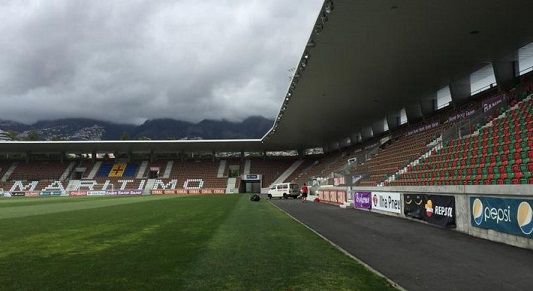 PortuGoal resumes its series of in-depth analyses of Portugal’s lesser known teams by turning the spotlight on Marítimo.
PortuGoal resumes its series of in-depth analyses of Portugal’s lesser known teams by turning the spotlight on Marítimo.
In 2016/17, after a poor start and a change of coach early on the campaign, the islanders have been on a fabulous run.
Marítimo are the only team in Portugal to beat Benfica this season, have risen to 7th in the standings and are very much in contention for Europa League qualification. Tiago Estêvão explains the reasons behind their success.
Since we’ve covered Nacional in this series already, I believe it would only be fair for us to cover Marítimo as well before any readers from Madeira get too mad at me. Marítimo has been one of the league’s most interesting teams so there’s plenty to stick around for.
Traditionally the island’s top club, Marítimo’s last European campaign happened during the 2012/13 season and saw them face Alan Pardew’s Newcastle, Club Brugge and Bordeaux. Pedro Martins was the commander back then but has moved on – as has the entire team from then – and the club struggled to find a replacement that delivered results-wise. That was four seasons ago and everyone knows how that is such a massive time difference when it comes to football – did I mention Newcastle were in the Europa League?
Ramos makes immediate impact
When PC Gusmão was appointed this summer, it just looked like a bad idea. An old-school Brazilian coach gets his first European gig and finds himself having to replace key players like Ruben Ferreira, João Diogo, Salin or Tiago Rodrigues in the summer. Long story short, he was out by mid-September after five matches that brought a single win and four defeats. The chosen one to replace him was Daniel Ramos, a manager who has been slowly climbing the Portuguese football ladder for 15 years. He arrived in second division Santa Clara in the summer and had 7 wins in 8 matches by the time he made the jump. Under the new coach things clicked from the start and now Marítimo sit 7th tied with Chaves, following the European places closely. The table below shows just how well Ramos has done since his appointment.
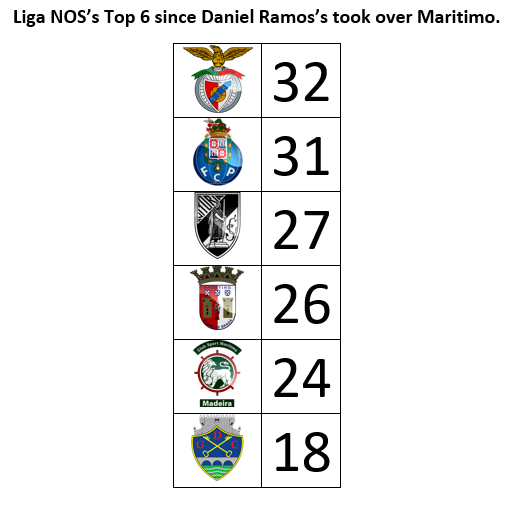
The Barreiros Stadium was renewed in early December, and since then, the team has had the highest average attendance in terms of percentage of stadium capacity in Portugal and it’s not difficult to explain why: Daniel Ramos has made the place a fortress, with zero defeats at home since his arrival – five wins and two draws – translating into 17 of their 27 points in the league so far. The run is even more impressive if you look into it and see that this sequence included wins over Benfica (the only team to overcome the champions so far) and Braga, plus a tie against Sporting. Not competing in any other competitions until the end of the season and with manager Ramos well settled in his first top-flight job, Marítimo has everything to go all out in the second half of the season. So let’s see how this has been happening.
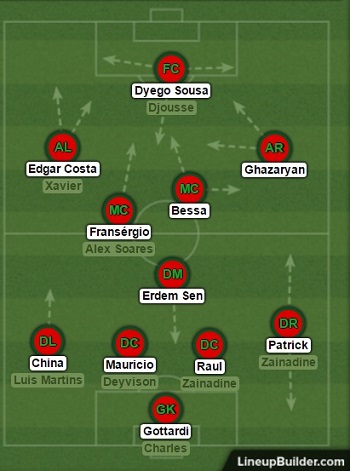 Rock solid defence
Rock solid defence
Let’s start from the back since that’s been the entire foundation of this team: they have only conceded 16 goals in the league so far (4th best) and seven of those were in the first five matchdays – with PC Gusmão in charge. This means that they’ve conceded only 9 goals in 13 league matches since the managerial switch. In goal, Gottardi has been the main man, keeping seven clean sheets so far. The goalkeeper is known for his seasons with Nacional but this summer he made the always risky move to the island rivals. At 31 he’s peaking and still has a lot of time on his side but is unfortunately injured for the rest of the season. Charles has been the replacement but already conceded three in the two matches played – not necessarily directly his fault but still concerning – and Amir Abedzadeh just arrived from third tier Barreirense to be another option.
The Brazilian centre-back duo of Maurício and Raul Silva have been mirroring each other in the backline. They are in the league top ten for interceptions (with 3.3 and 3.4 per game) and for blocks (close to 1 blocked shot per game for each), while also having 5 (Maurício) and 4.5 (Raul) clearances per match.
Whoever will end up in goal for the Madeira Lions will have the best – in my eyes – centre-back partnership in Portugal this season in front of him. On a par with Porto’s duo of Marcano and Felipe, Raul Silva and Maurício have been outstanding. Raul seems to be finally hitting form, having played 18 matches – the same as he did in the entire 2014/15 season with the club. Maurício, at 24 (3 years younger), was always going to be a safe bet: the ex-Porto B defender had quality, and just needed a space in the league where he could show it continuously.
Talking Tactics
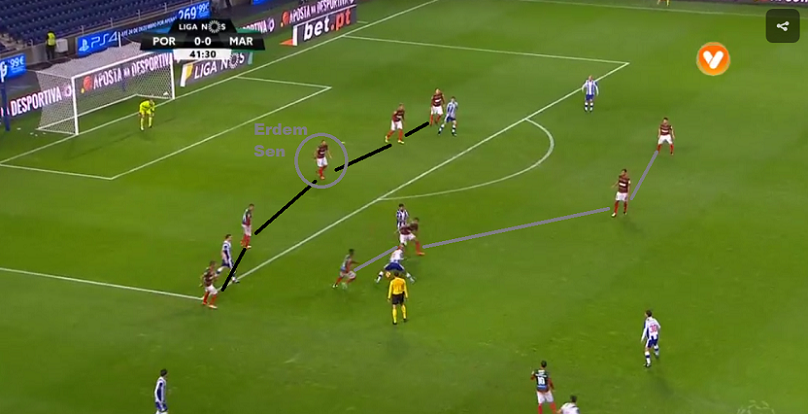
IMAGES 1 & 2 – In the first image we see Marítimo in their defensive phase, away against Porto. The 5-4-1 mentioned is perfectly shown here, with Erdem Sen being the key point – dropping in between the centre-backs into the box, acting as an extra defender. In this match Ghazaryan was the false nine, that’s why you see him roaming and not being part of the second line of four.
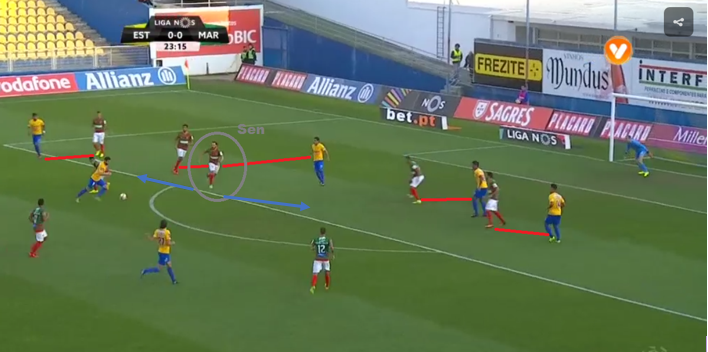
In the second image more of Sen’s role is explained: in the match against Estoril, we see each player marking a single opponent (Cattenacio style if you will), although not necesserely with the best spacings. Either way, Sen acts as the extra defender and he’s the one that covers more ground due to not being stuck to a specific opponent and comes out to pressure first. Neither of the two plays shown above got Marítimo’s opponents more than a longshot or a scramble in the box – Marítimo is one of the teams that allows more shots to be taken in the league but they make the opposing side take them from awkward angles or distance (blocking a ton of shots as well).
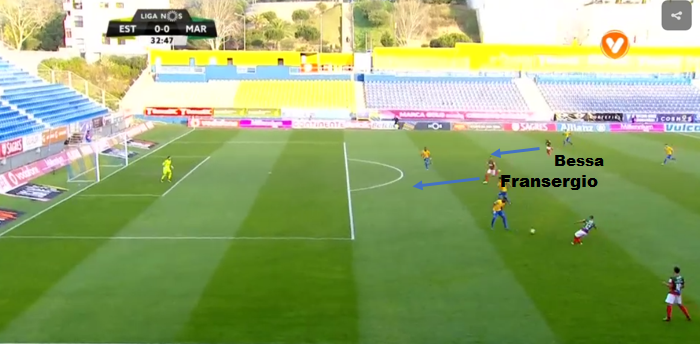
IMAGES 3 & 4 – Here we have some typical offensive movements from the team. In the first image, Edgar Costa took advantage of a mispass from Estoril’s GK and – to make the most of it – he awaited the runs of the duo of centre-midfielders who would eventually have a good chance in the box. The striker, Djousse, is on the wing.
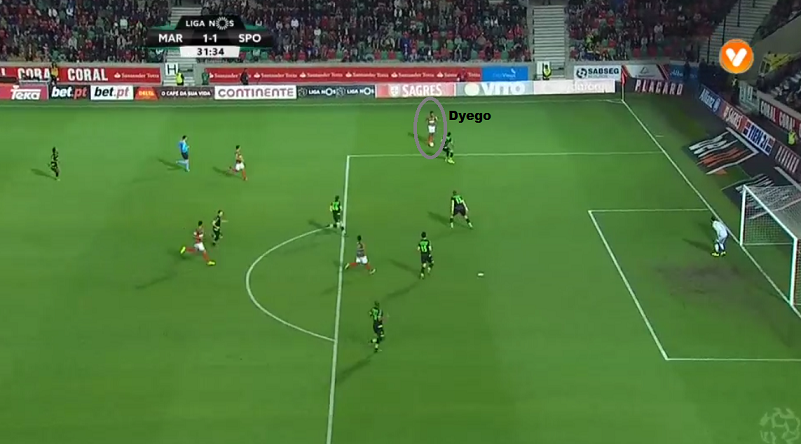
In the second image we see what I mention about Dyego Sousa: the striker gets a through ball played to him and gets it via a movement towards the wing: quickly a chance appeared with the opposite winger and one of the CM’s entering the box. This one ended with Dyego going on his own and striking the bar after a movement inside because, you know, strikers will be strikers – but he had passing lanes nontheless.
Set-piece threat
But their efforts go way beyond their defensive work: the duo has three goals each, only one player in the team has scored more. Marítimo is the third team in the league with more goals scored from set-pieces (10), causing such a threat at corners/wide free-kicks that they end up relying on them offensively: 71% of the team’s scoring efforts have come from set-pieces (including two penalties). Everyone knows how difficult it is to defend a well-trained set-piece but you could argue that shutting down their set-piece routines pretty much renders their attack infertile.
On the right, Patrick Oliveira has been the go-to man. The Brazilian has had a very consistent season, reliable defensively and popping up with the odd assist when going forward – with three, he’s joined top assist provider at the club. He tends to show up in big games, too: Patrick was key in the wins v Braga and Benfica. On the left, things aren’t so clear. Fábio China had an okay start but injuries have been slowing him down and due to the lack of replacements in the squad, CB Deyvison has often been adapted. While it adds another defensive layer and yet another threat for set-pieces, there’s a lack of offensive support on that side.
The issue was recently taken care of with the signing of Luís Martins. The ex-Benfica left-back known for his offensive prowess and quality set-piece delivery (go figure) arrives from Granada. To wrap up the defence there’s yet another transfer worth mentioning: Zainadine, ex-Nacional, returned to Madeira from China and is a quality asset. Able to play either CB or RB, I think he’ll have trouble breaking through the CB pairing that is established but will give important contributions to the team.
Key man
Anchoring the midfield, there’s the player who has made everything tick and who took the most advantage of Daniel Ramos. Sure Erdem Sen arrived in the summer, but I doubt it was the past coach’s wish that got him to Madeira since he only really got going after Gusmão’s departure. Much like I said about Palhinha in my Belenenses team analysis, Erdem Sen is a ball-winning defensive midfielder who protects the Madeirenses’s backline. In the league, only a single player has more interceptions per game than him (3.6) and in the air he tends to rise up to the challenge – winning 2.6 aerials per match, as many as Sporting’s Coates (who is the tallest outfield player in Portugal). The Belgium-born Turkish midfielder tends to slot in between centre-backs during build-up and when the team is mass-defending, almost in a 5-4-1. For a defensive midfielder, his passing accuracy isn’t outstanding (78%) and his average of 36 passes per game also doesn’t impress much but it’s all related to how the team plays: the lack of tendency to retain the ball and the quickness in transition with the team focused on getting the ball to their wingers is reflected on those numbers.
Ahead of him Bessa and Fransérgio are the usual choices. Fransérgio has played everywhere in midfield for the past couple of seasons with Marítimo, but I believe the role he is now taking on as a transition midfielder slightly ahead of Sen is where he can thrive. Simply put, he’s just not accurate enough of a passer to dictate the match’s tempo or to be the one initiating build up, but he has shown he can be difficult to knock off the ball and an absolute threat when appearing in the opposite box – the captain is in the league’s top 10 for most shots per game (2.5) for a reason. For this he needs space to run into, though, and he gets exactly that as a number 8.
The other piece in midfield is usually Eber Bessa, who tends to play slightly more advanced and is the first one to pressure the opposition out of the trio, as illustrated by the fact that he makes one of the highest amounts of fouls in the team. With two goals already, he likes to try his luck from range and set-pieces, and tends to work his way through half-spaces behind the forward. Interestingly enough, no one is fouled more often than him in the team, almost 3 times per match.
Intelligent wingers
As of late, the wings have been occupied by Ghazaryan and Edgar Costa. Despite how young he looks taking on defenders on the pitch, Edgar is 29 already and has been a constant for Marítimo in the past couple of seasons. More than just someone full of flair and ready to take on defenders, Costa is the modern winger who tends to both try to create danger himself (2 shots per game) and sets up his teammates with ease: in the Liga NOS only Agra (Nacional) and Pizzi (Benfica’s maestro) have more key passes per match than him (2). All of this gives the Madeira-born player a key role in Marítimo’s offensive process and the ability to play from both wings with his dangerous right foot.
On the other side is one of the most interesting players in the league: Ghazaryan is arguably Armenia’s second best player (after some guy called Mkhitaryan who plays under Mourinho, I believe) but only now is he able to play consistently after leaving Ukraine. Probably the team’s most intelligent player on the ball, Ghazaryan is known for his ability to create chances: good ball control and an accurate passer – 82% passing accuracy for someone playing so high up the pitch is outstanding – he has already picked up 3 assists. His understanding of the game allows him to take on different roles, including to play as a false nine in major matches when Dyego Sousa was unavailable, where his composure and ability to split defences with his movement were tested to a different level.
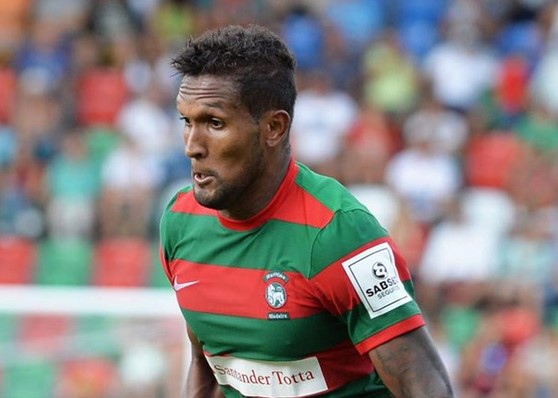 Untameable Dyego Sousa
Untameable Dyego Sousa
Finally, the troublesome Dyego Sousa is now officially back to play after having quite a few matches away from the pitch due to a pre-season incident. Either way, Sousa seems to be ready to make a consistent run in the team now and do they need him. Dyego Sousa is one of the most well-rounded strikers in the league: at 190 cm tall, he’s an absolute hassle for defenders in the box, both when it comes to finishing crosses and bringing his teammates into the play through his lay-offs. Despite his tremendous frame the Brazilian isn’t slow at all, being quite hard to stop when it gets going and often appearing in space via through balls from his midfielders and full-backs.
In only eight starts the 27-year-old already has 5 goals and one assist. More than that, in the league only Gelson (Sporting), Podence (Moreirense), Corona and Brahimi (FC Porto) complete more dribbles per match than Dyego with 2 – you may consider this surprising but the truth is Dyego brings a lot more than what he looks at first sight and it doesn’t hurt that the forward tends to have so many metres ahead of him so often due to Marítimo’s playstyle.
Some other options include: Xavier, who has been a reliable winger when called upon but brings less of an end-product that the usual starting duo, Alex Soares, who has close to 100 matches for Marítimo and who has done well when he did start but has had trouble when trying to impact from the bench, and Djousse – the team’s super sub if you will, usually called upon to make an impact. Two 21-year-olds, Gildo and Luan, both recently arrived and will be low risk bets that may boost the team’s attack, while also getting experience with the B side if needed.
Good blend but with flaws
Overall I think Daniel Ramos and his squad are blending in perfectly and have everything to keep their form as we enter the second half of the season. That said, there are still flaws that can be exploited. They are one of the teams to play more in their own half, one of the teams that play the fewest short passes per match, and while you can argue that this is part of their simple playing style, it’s quite difficult for them to break down a team that sits deeper in their own midfield.
Offensively they are heavily reliant on set-pieces to grab goals, as I mentioned previously, with Marítimo only scoring five from open play this season – the least of any team in the league. That said, Dyego Sousa’s return may shift things slightly with the powerful striker exposing the team to goalscoring situations that were not there when he wasn’t on the pitch. Look out for this team, Europe may be 7 points away but you shouldn’t question the ambition of this Catennacio side from Madeira.
By Tiago Estêvão
Related: In-depth team analysis: Belenenses
Related: In-depth team analysis: Nacional da Madeira
Related: In-depth team analysis: Vitória de Guimarães

